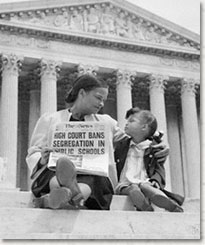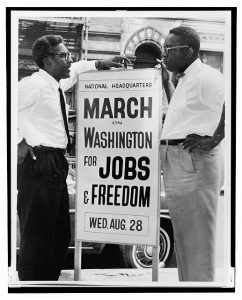Brown v Board of Education, (1954)
 Brown v the Board of Education was the historic Supreme Court ruling that unanimously held that segregation in public schools violated the Equal Protection Clause of the 14th amendment. The image above shows a mother, with hope in her eyes, looking into the eyes of her daughter. The daughter is too young to comprehend what just happened, but now she will have a more fair opportunity at having an education. The picture takes places on the steps of the Supreme Court. The mother is holding a newspaper with the headline “High Court bans segregation in public schools”. The significance of the decision over turns Plessy v Ferguson (1954) which made it legal to segregate public facilities as long as they were separate but equal. NAACP lawyers brought class action suits in multiple states stating that separate but equal is not equal. Thurgood Marshall was the head of the NAACP defense team and he would later be appointed as the first African American Supreme Court justice. Arkansas was still hesitant to allow African American students into its school and Governor Faubus of Arkansas called out the state National Guard to prevent the Little Rock Nine from entering Central High School. President Eisenhower sent federal troops to Little Rock in order to give the Little Rock Nine protection. Brown vs the Board of Education gave African Americans a chance, even though they still had hurdles to overcome, they would persevere.
Brown v the Board of Education was the historic Supreme Court ruling that unanimously held that segregation in public schools violated the Equal Protection Clause of the 14th amendment. The image above shows a mother, with hope in her eyes, looking into the eyes of her daughter. The daughter is too young to comprehend what just happened, but now she will have a more fair opportunity at having an education. The picture takes places on the steps of the Supreme Court. The mother is holding a newspaper with the headline “High Court bans segregation in public schools”. The significance of the decision over turns Plessy v Ferguson (1954) which made it legal to segregate public facilities as long as they were separate but equal. NAACP lawyers brought class action suits in multiple states stating that separate but equal is not equal. Thurgood Marshall was the head of the NAACP defense team and he would later be appointed as the first African American Supreme Court justice. Arkansas was still hesitant to allow African American students into its school and Governor Faubus of Arkansas called out the state National Guard to prevent the Little Rock Nine from entering Central High School. President Eisenhower sent federal troops to Little Rock in order to give the Little Rock Nine protection. Brown vs the Board of Education gave African Americans a chance, even though they still had hurdles to overcome, they would persevere.
March on Washington (1963)

A. Philip Randolph had the idea for the March on Washington and recruited Bayard Rustin, Dr.King, and Cleveland Robinson to help with the March. Mr.Rustin and Mr.Robinson are meeting in the picture above while promoting the March on Washington. The March had 10 goals and the main goal was a Fair Employment Practices Act which barred discrimination by governments, employers, and trade unions. The March had participants from the “Big Six” which included SNCC, CORE, SCLC, National Urban League, the NAACP, and Randolph’s Brotherhood of Sleeping Car Porters. Each organization had different individual goals, yet the common goal was to make life easier for African Americans. The different Civil Rights leaders did not come together easily, nonetheless they put aside their differences to lead a successful March. Some considered Rustin to be a risk to lead the March due to the fact that he use to have ties to the Communist Party and he was a closeted gay man. A. Phillip Randolph took over the lead of the March and Rustin served by his side. Rustin served as a mentor to Dr.King introducing him to Gandhi’s non-violent teachings. Rustin also worked behind the scenes to help Dr.King with the Montgomery Bus Boycott. Rustin had a controversial life and other Civil Rights leaders were uncomfortable if he led monumental events. Rustin was never afraid to be himself and continued to overcome every challenge presented his way.
“I Have a Dream” Dr.King (1963)
ntentid=http://okra.stanford.edu/media/audio/630828000.mp3 audio=true]
The Martin Luther King Jr speech is one of the most famous speeches in America. At the time of the speech, most Americans either loved or hated Dr.King. Dr.King will always be remembered as a strong figurehead of the Civil Rights movement. From the Montgomery bus boycott to the Letter from a Birmingham jail Dr. King has had a huge impact on the overall impact of the Civil Rights Movement. The speech was delivered in 1963 in front of a crowd that had 250,000 people at the March on Washington. Hope was the central context of the speech, hope that his children’s future will be better than his past. The signature line of the speech “my four little children will one day live in a nation where they will not be judged by the color of their skin but by the content of their character”. The March was considered a great success and a big part of the success was the speech. Even though the speech inspired many, times were still difficult for African Americans. Three weeks after the Speech, three girls were killed in the bombing of Sixteenth Street Baptist Church in Birmingham, Alabama. The speech is still talked about to this day and is a crucial part in explaining American history.
